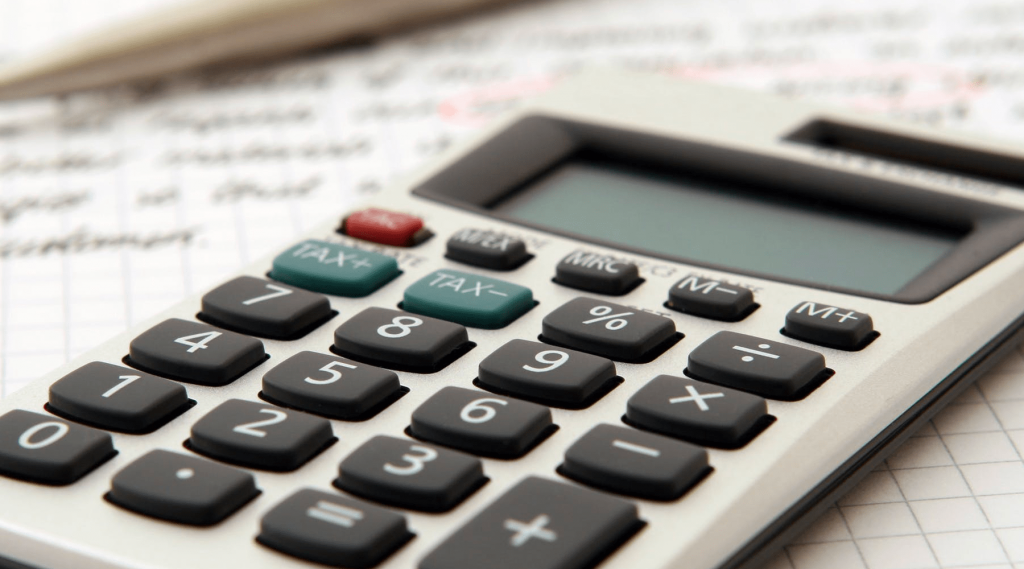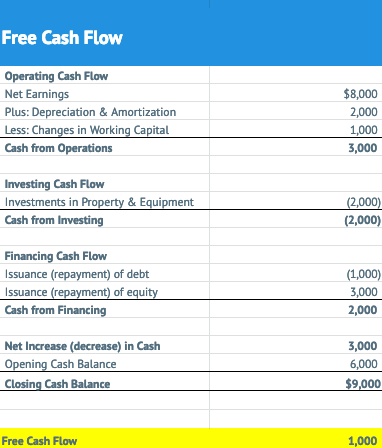Downloadable Calculator for Free Cash Flow Formula
What is the free cash flow formula?
According to Investopedia, free cash flow is the amount of cash your business makes after cash goes out to support its operations and sustains its capital assets. Free cash flow is different from your net income or earnings because it measures profitability without including non-cash expenses on the income statement, but incorporates spending on assets and equipment and changes in working capital.
Simply put, your free cash flow is the amount of money you have left over after your company pays for:
Debts
Expenses
Employees
Rent
Fixed assets. etc.

Your free cash flow represents the amount of cash that your company is free to spend as it sees fit. You can use different types of free cash flow to predict how your company will perform. Therefore, free cash flow is important for making decisions about the future direction your business may take.
For instance, you can determine whether you want to move in any of these directions:
Expansion
New product development
Reducing debt
If you are trying to sell your company, free cash flow can have a significant impact on how much someone is willing to pay for it. Potential buyers will be looking for businesses that are showing high or improving free cash flows to get the best return on their investment. Additionally, the free cash flow measurement demonstrates your company’s ability to generate cash.
What is the free cash flow formula?
To work out your free cash flow formula, review your cash flow statement and subtract the capital expenditure from operating cash flow.
The free cash flow formula is:
Cash from Operations – Capital Expenditures
Cash from Operations
Cash from operations is the amount of cash you need to fund your day-to-day operations. It’s normally recorded before financing and investment cash flow and is in bold on the cash flow statement. Operating cash flow is sometimes referred to as “working capital”.
Capital expenditures
The capital expenditure is located in the cash flow statement, under cash flow from investing activities. The capital expenditure used in the free cash flow calculation is usually the amount of money that’s needed to keep your business going at its current rate.
To work out your free cash flow, you must enter some details that relate to your operating cash flow and capital expenditure.
The calculator below will help you to work out your company’s free cash flow.
How to calculate cash flow
Here is an example of how to work out your free cash flow:
1. Section one
Start with your net earnings ($8,000) – Your sales revenue after every operating expense, tax, interest, and stock dividend has been paid.
Add depreciation and amortization ($2,000) – How you spread the cost of your assets over a specified period of time.
Minus changes in working capital (-$1,000) – The capital you use for your day-to-day operations.
This gives you the cash from operations figure of $3,000
2. Section two
Investing cash flow – The amount of money you have spent making investments over a specified time period.
Investments in Property & Equipment (– $2,000)
This gives you the cash from investment figure: -$2,000
3. Section three
Financing cash flow – These are the external activities that allow you to raise money and pay back money that is owed.
Issuance (repayment) of debt (-$1,000)
Issuance (repayment) of equity $3,000
You subtract the issuance of debt ($1,000) from the issuance of equity ($3,000)
This gives you the cash from financing figure: $2,000
4. Section four
Net increase (decrease) in cash: $3,000
Opening cash balance – ($6,000) – The balance from the end of one accounting period that is brought forward to the current accounting period.
Add the Net increase (decrease) in cash and the opening cash balance.
This gives you the closing cash balance figure of $9,000.
To find the free cash flow add cash from operations ($3,000) and investments in property and equipment (-$2,000).
Your free cash flow is $1,000.
The table below shows a representation of the example above:

<center><span id="hs-cta-wrapper-1f017a21-4fdc-4f93-90f3-4b1f88693475" class="hs-cta-wrapper"><span id="hs-cta-1f017a21-4fdc-4f93-90f3-4b1f88693475" class="hs-cta-node hs-cta-1f017a21-4fdc-4f93-90f3-4b1f88693475"><a href="https://cta-redirect.hubspot.com/cta/redirect/3040938/1f017a21-4fdc-4f93-90f3-4b1f88693475" target="_blank" rel="noopener"><img id="hs-cta-img-1f017a21-4fdc-4f93-90f3-4b1f88693475" class="hs-cta-img" style="border-width: 0px;" src="https://no-cache.hubspot.com/cta/default/3040938/1f017a21-4fdc-4f93-90f3-4b1f88693475.png" alt="Download this free Cash Flow Formula Calculator"></a></span></span></center>
<center><br><em><strong>(Be sure to copy the Google Sheet in order to use: File – Make a Copy)</strong></em></center>
<center><span id="hs-cta-wrapper-1f017a21-4fdc-4f93-90f3-4b1f88693475" class="hs-cta-wrapper"><script src="https://js.hscta.net/cta/current.js" charset="utf-8"></script><script type="text/javascript">// <![CDATA[ hbspt.cta.load(3040938, '1f017a21-4fdc-4f93-90f3-4b1f88693475', {}); // ]]></script></span></center>
How to calculate free cash flow
Before you can calculate your cash flow you need to generate a free cash flow statement. The type of free cash flow statement you use will depend on your company’s needs. The following are five different types of cash flow:
EBITDA – This is earnings before interest, tax, depreciation and amortization.
Cash flow from operations.
Free cash flow.
Free cash flow to equity.
Free cash flow to firm.

The first two types of cash flow calculations are not free cash flow formulas.
Here are brief descriptions of these formulas:
EBITDA
You can calculate this cash flow formula using your income statement. In some cases, amortization and depreciation may not appear as an income statement line item. In this case, you can arrive at this amount using a cash flow statement.
This formula is simple.
Find your net income then add taxes, depreciation, and amortization. You have your EBITDA. However, this formula can be significantly different from true cash flow metrics. As a result, it can be considered a substitute for cash flow.
Cash flow from operations
This is a measurement of cash that your business generates or uses in the course of its normal operating activities.
The formula here involves the basic EBITDA in which you take your net income figure and add back amortization and depreciation amounts. Then you also add non-cash figures for unrealized gains or losses, write-downs, and stock-based compensation.

The cash from operations formula also differs from EBITDA in that it adds net working capital changes such as inventory, accounts payable and accounts receivable. One item that it does not include is capital expenditures.
Free cash flow
The ‘leftover’ money after your company has paid for its capital expenditures out of its operating cash flow.
Free cash flow to equity
This free cash flow formula shows how much cash is available to equity shareholders when all expenses, debts, and reinvestments are paid. As this type of cash flow involves shareholders it’s unlikely to be used by small and medium-sized companies.
Free cash flow to firm
This type of free cash flow is the amount of cash flow that is available from operations following the payment of expenses, depreciation, working capital, and investments. This provides an indication of how profitable your company is when all expenses are paid and reinvestments are made.
Your company has to take all precautions to protect its cash flow because without it, you may be at risk of being unable to meet your basic business obligations such as payment of utility bills, loan payments, and payroll.
To work out how much cash you have available, add up your cash flow from all your business activities for a specified period of time to come up with the amount of available cash you have at your disposal for that time period. Cash flow is usually generated from the following sources:

Operations
When determining your cash flows from operations, you’re evaluating your cash inflows and outflows resulting from your core business operations, which include:
Product sales
Asset sales
Debtor receipts
Other income
Cash outflows include the following expenses:
Credit card fees
Advertising and marketing
Payroll
Bank fees and other charges
Rent or mortgage payments
Utilities
Attorney fees
Investments
The following are steps to take to calculate your cash flow for your cash flow statement:
Find your ending cash balance from the previous year – This information can be found if you have already created a cash flow statement previously.
Calculate the total of all cash and cash equivalents – Review your balance sheet to find the total of your company’s cash and cash equivalents.
Determine the beginning cash balance for the present year – You will need to use the balance from the previous year for the current year.
Begin with your net income – To work out your net income, you must subtract your operating expenses from your total revenues.
Take depreciation and amortization into account – Amortization and depreciation are classified as non-cash expenses that show a decrease in your asset’s value over a given period of time.
Adjust for accounts payable and accounts receivable – Accounts payable is the amount of money your company has to pay creditors. Accounts receivable is the money that is owed to your company for the goods or services it provides.
Work out the net cash that is generated from operations – You need to begin with net income then add amortization and depreciation.
Assess your investments in capital– Capital investments consist of the different types of funds that your company has used to purchase equipment.
Make a decision about the effect of finance activities – Different types of financing activities include long term debt (issuing and redemption) and payment of stock dividends. Finance activities can have both a positive and a negative impact on your company.

Take into account financing and investments – Subtract money that has been used to buy capital equipment. You can also deduct money to pay dividends or cash in shares.
Work out the net increase or decrease to cash – You need to find out whether there was a net increase or decrease to your cash for the present year.
Find out the ending cash and cash equivalents – You must start with the ending cash balance from the previous year, then add the net decrease or increase from the present year.
After you’ve created a cash flow statement for your company, you should use this information to assess how cash is flowing in and out of your company. A cash flow statement gives you a clear picture of how your company is performing and what needs to be improved.
Drawbacks of the free cash flow formula
The free cash flow method may not be the most reliable method of determining how much ‘spare’ cash a company has available. The free cash flow for a company can be manipulated to a certain extent. For example, a company can extend the time that it takes to settle debts to keep cash for longer. Alternatively, a company can also reduce the time that is permitted to collect debts they are owed. Both of these scenarios could result in the calculation of free cash flow being skewed.
Benefits of free cash flow formula
The free cash flow formula can offer a signal that your business is in good financial health. This method of determining your company’s fiscal health prevents it from borrowing unnecessary money to add to its cash flow. Essentially, the existence of free cash flow indicates that your company is operating efficiently and is ready to meet the challenges in relation to growth and expansion.
However, while the existence of free cash flow in a company is a positive indicator, the lack of free cash flow is not necessarily a negative indicator. This is because companies who have recently started, or those experiencing a temporary growth phase, generally need cash. As a result, there may be a temporary situation when the amount of cash available for use is restricted.

The free cash flow formula is a good indicator of how your company is performing. However, it should not be the only measurement that’s used. It’s advisable to take advantage of different accounting formulas to gain a true picture of all different aspects of your company’s financial performance.
If you hire hourly workers, one area of your business that can have a significant impact on your cash flow is labor costs. Failure to schedule your staff properly can negatively affect your profits.
Deputy’s staff scheduling software provides practical features, such as auto-scheduling. This provides an accurate forecast of the amount of staff you’ll need to cover different shifts. Auto-Scheduling helps you avoid overstaffing and understaffing, which in turn helps your customers receive a better experience, all while you protect your bottom line.
Click on the link below to start your free trial and to see first hand why Deputy is the highest rated workforce management solution by G2 Crowd.
<center><span id="hs-cta-wrapper-bb5b5a9c-0623-4768-b1d3-30732fb7dbc3" class="hs-cta-wrapper"><span id="hs-cta-bb5b5a9c-0623-4768-b1d3-30732fb7dbc3" class="hs-cta-node hs-cta-bb5b5a9c-0623-4768-b1d3-30732fb7dbc3"><a href="https://cta-redirect.hubspot.com/cta/redirect/3040938/bb5b5a9c-0623-4768-b1d3-30732fb7dbc3" target="_blank" rel="noopener"><img id="hs-cta-img-bb5b5a9c-0623-4768-b1d3-30732fb7dbc3" class="hs-cta-img" style="border-width: 0px;" src="https://no-cache.hubspot.com/cta/default/3040938/bb5b5a9c-0623-4768-b1d3-30732fb7dbc3.png" alt="TRY G2 CROWD'S #1 WORKFORCE MANAGEMENT APP"></a></span><script src="https://js.hscta.net/cta/current.js" charset="utf-8"></script><script type="text/javascript">// <![CDATA[ hbspt.cta.load(3040938, 'bb5b5a9c-0623-4768-b1d3-30732fb7dbc3', {}); // ]]></script></span></center>
